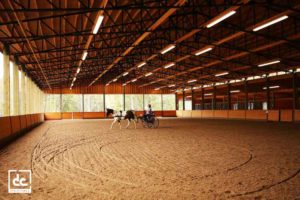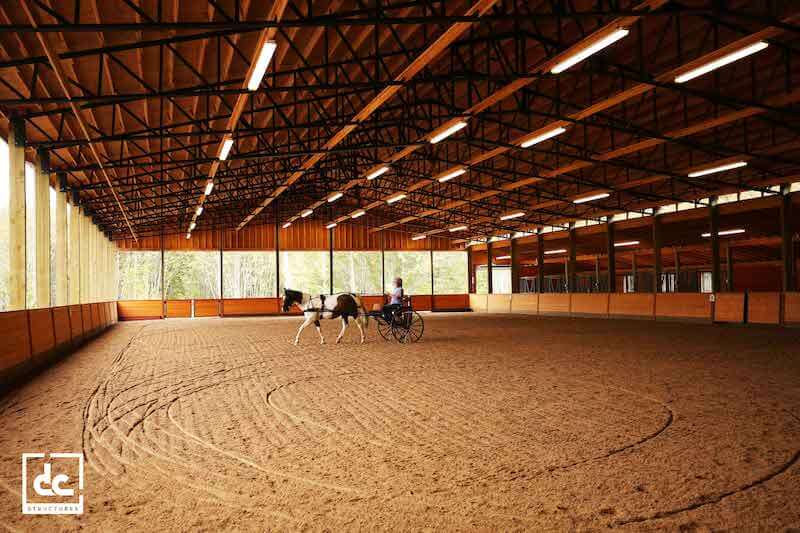By Dustin Gruetter, President and Founder of DC Structures

Arena footing—seems easy enough, right? Decisions surrounding the footing you choose for your riding arena are a lot more complicated than you might think. Poor footing will subject your horse to increased risk of injury and long-term degenerative problems. Therefore, selecting footing calls for an informed and measured approach that takes a variety of factors into consideration.
When it comes time to evaluate potential arena footing materials, you have to ask yourself several important questions. First, what kind of maintenance will this footing require? Match that answer against the time investment you can reasonably expect to dedicate to arena maintenance (be realistic). Neglected arena footing can present real health hazards for your horses.

The next question you have to ask is, does this footing material make sense for its intended use? Arena footing in a boarding or training facility will be subject to a lot more wear and tear than footing used for personal recreation. Further, the type of sport or recreational activities the footing will be used for should also factor into your decision. For example, arena footing used for barrel racing needs to hold up a lot better than footing used for saddle seat riding.
Additionally, you must ask how your chosen arena footing material will interact with the natural environment. The use of sand in super wet climates, for example, can result in large pools of water and goopy spots that feel like quicksand. Internet forums are your friend as you undertake this process, so take the time to comb through tried-and-true advice that’s all laid out for you in relevant message boards.
Ultimately, you should consider creating a combination of arena footing materials that will better suit your intended uses and natural environment. More often than not, it’s a medley of resources that come together to create the perfect arena footing. Don’t get so hyper-focused on finding “the one” that you neglect your practical creative tendencies.
Lastly, do the positives of using your preferred arena footing or footing mixture outweigh the negatives? This might seem obvious, but the major takeaway here is that the decision surrounding your selection of arena footing is far from cut and dried. If it sounds complicated, that’s because it is. Of course, any equestrian knows that caring for horses is no easy task! As you are guided by the will to create a safe environment for horses and their riders, everything—including dirt, sand and wood—will settle into place just fine.
That said, some aspects of your arena footing are non-negotiable. For starters, all arena footing must be absolutely free of holes and uneven or shifting surfaces. It has to be stable, yet shock absorbent, and it must also be non-slippery with excellent traction.
Arena footings that meet these three necessary requirements can be comprised of a variety of materials—both natural and synthetic—as well as a combination of footing types. While there are countless products and formulas on the market, the most common footing materials are made from clay or silt-based dirt, sand or wax-coated sand, and wood products or natural and synthetic fibers. Again, the arena footing materials you choose should be right for your regional environment and equestrian discipline.
Before you even think about choosing an arena footing, you must have 100 percent confidence in your riding arena’s base. Solid arena bases adhere to high standards for the three D’s: drainage, durability and depth. If you live in a wet region or know your arena will be getting lots of traffic, it may be necessary to go beyond standard recommendations.
- Drainage: Opt for a strong base that will enable water to seep into the ground rather than flood the surface.
- Durability: Make sure your base is compacted above a 90 percent density, so it will hold its integrity and keep rocks from creeping to the top.
- Depth: Keep your base layer at no less than four inches deep and up to one foot deep if your equestrian activities call for more support.
An Oregon native, Dustin Gruetter is a serial entrepreneur with a diverse portfolio of businesses to run. His two largest roles are as president of both DC Builders, an elite design and construction firm, and DC Structures, a construction materials company. With more than a decade of leadership and management experience, Dustin lends his expertise to Eris Creative as the head of business development. Dustin lives in Portland with his wife Ilanah, son Maxton, daughter Violet, and dogs Piper and Marley.

